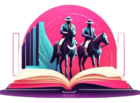In the enchanting world created by J.K. Rowling, “Harry Potter and the Philosopher’s Stone” is the inaugural chapter in the saga of the Boy Who Lived. From the Dursleys’ mundane existence to Hogwarts’s magical realm, this first installment weaves a tapestry of adventure, friendship, and the eternal battle between good and evil.
You should also know that this book is known as “Harry Potter and the Sorcerer’s Stone” in the US.

Without further ado let’s begin this.
Harry Potter and the Philosopher’s Stone Book Summary
The journey begins with Harry’s mistreatment at the hands of the Dursleys, his non-magical relatives. Mysterious letters, delivered by owls, disrupt their attempts to keep Harry in the dark about his magical heritage. The arrival of the giant Hagrid on Harry’s eleventh birthday marks the turning point, introducing him to the wizarding world and the revelation of his fame as The Boy Who Lived.
Hagrid guides Harry through Diagon Alley, a magical shopping district, where he acquires school supplies and learns about the dark wizard Voldemort. Boarding the Hogwarts Express, Harry forms friendships with Ron Weasley and Hermione Granger, setting the stage for the trio that will become central to the series.
Upon arrival at Hogwarts, the Sorting Hat sorts students into houses, placing Harry in Gryffindor alongside Ron and Hermione. As classes commence, suspicions arise around Professor Snape’s intentions, adding an element of mystery. A midnight duel encounters with magical creatures, and the discovery of the Mirror of Erised deepen the sense of wonder and intrigue.
The plot thickens with the mystery of the Philosopher’s Stone, guarded by enchantments and a three-headed dog named Fluffy.
Halloween brings a petrified Hermione, raising concerns about the Stone’s safety. The Quidditch matches, Harry’s Nimbus 2000 broomstick, and the discovery of Nicolas Flamel add layers to the narrative.
The Forbidden Forest becomes the setting for a pivotal moment as Harry and his friends encounter a dragon, leading to a detention that propels them closer to the truth. In a climax filled with enchantments and obstacles, the trio confronts Professor Quirrell, revealing Voldemort’s presence and thwarting his attempt to steal the Philosopher’s Stone.
The journey concludes with Gryffindor winning the House Cup, and Harry, despite his triumphs, returns to the Dursleys for the summer. “Harry Potter and the Philosopher’s Stone” lays the foundation for a series that transcends age and genre, inviting readers into a world where the ordinary becomes extraordinary and where the magic of storytelling comes alive.
Harry Potter and the Philosopher’s Stone Fun Facts
Hidden References:
J.K. Rowling is known for incorporating hidden references and symbolism in her books. In “Philosopher’s Stone,” the street where the Dursleys live is named Privet Drive. The word “privet” is a shrub often used for hedges, suggesting the Dursleys’ desire to be unremarkable and blend in.
The Leaky Cauldron’s Real Location:
The Leaky Cauldron, the wizarding pub and inn, is said to be located in London on Charing Cross Road. However, there is no pub on Charing Cross Road in reality. The film adaptation uses a different location, but the book’s description places it there.
Platform 9¾ Inspiration:
The idea of Platform 9¾, where students catch the Hogwarts Express, was inspired by a real place. J.K. Rowling got the idea from King’s Cross Station in London, where there is a barrier between platforms 9 and 10. In the book, witches and wizards access the platform by running through the barrier.
The Hogwarts Houses:
The names of the Hogwarts Houses have Latin origins. Gryffindor means “golden,” Hufflepuff means “hardworking,” Ravenclaw is a combination of “raven” and “claw,” and Slytherin is a play on the word “slithering.”
The Mirror of Erised:
The inscription on the Mirror of Erised, “Erised stra ehru oyt ube cafru oyt on wohsi,” is a clever play on words. When read backward, it says, “I show not your face but your heart’s desire.”
Fluffy’s Role:
Fluffy, the three-headed dog guarding the trapdoor, is based on Cerberus, the three-headed dog in Greek mythology that guards the entrance to the Underworld.
The Philosopher’s Stone Concept:
The concept of the Philosopher’s Stone has roots in alchemical traditions. In mythology, the Philosopher’s Stone is believed to have the power to transform base metals into gold and grant immortality.
Quirrell’s Turban:
Quirrell’s turban is not just a fashion choice. It conceals Voldemort’s face on the back of Quirrell’s head. This foreshadows the revelation of Voldemort’s possession of Quirrell later in the story.
Nearly Headless Nick’s Full Name:
Nearly Headless Nick’s full name is Sir Nicholas de Mimsy-Porpington. The “Nearly Headless” part refers to the fact that he was beheaded but the axe was blunt, leading to a botched execution.
Wizarding Money:
The wizarding currency used in the books, Galleons, Sickles, and Knuts, is based on the medieval system of English currency. A Galleon is equivalent to 17 Sickles, and a Sickle is equivalent to 29 Knuts.
Feel free to share these fun facts with fellow Harry Potter fans!
That’s all for your Harry Potter and the Philosopher’s Stone Book Summary
I hope you had fun reading this Harry Potter and the Philosopher’s Stone Book Summary. To learn more about the Harry Potter full series, and read reviews of the other books in this series, go here.


Pingback: A Comprehensive Harry Potter Book Review